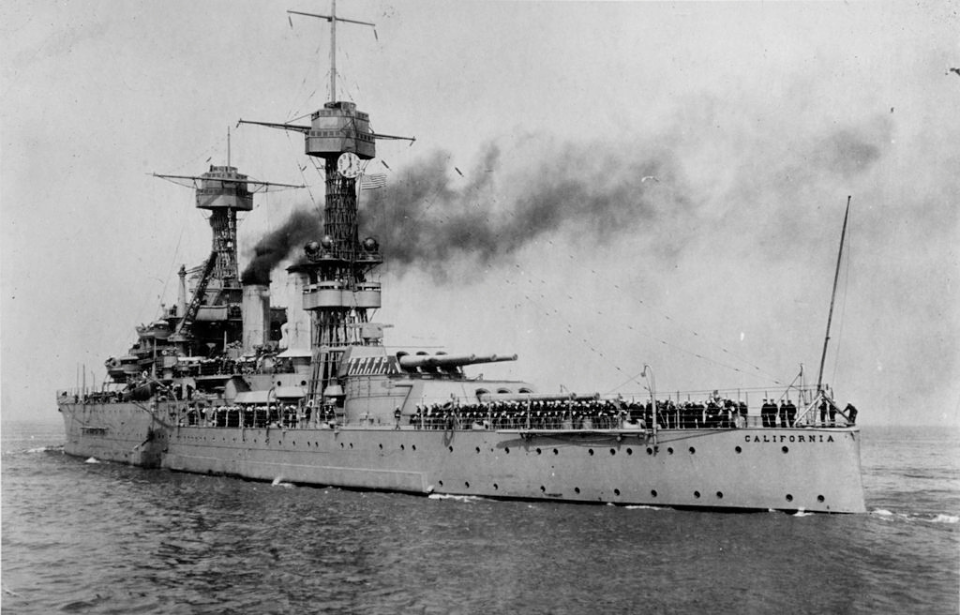
The USS California (BB-64) was the second of two Tennessee-class battleships. The vessel saw service throughout World War II, including being targeted by the Japanese at Pearl Harbor and in a kamikaze strike, both of which she survived. By the conflict’s end, four crew members had been awarded the Medal of Honor, showing the true bravery of both the ship and those who served aboard her.
Design and construction of the USS California (BB-44)
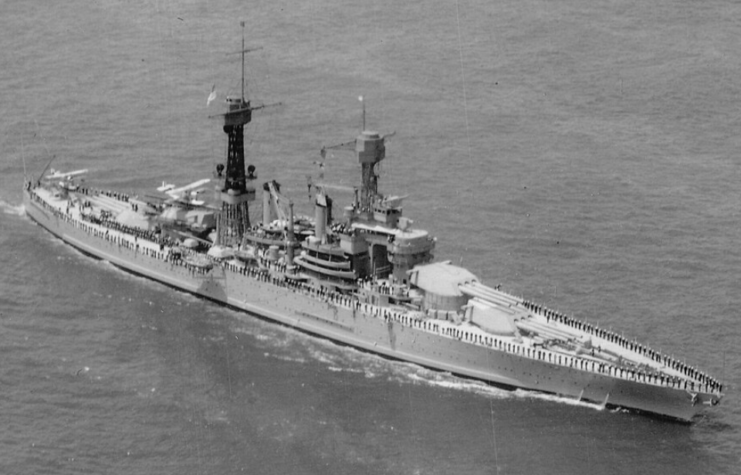
USS California (BB-44), 1927. (Photo Credit: US Navy / U.S. National Archives and Records Administration / Wikimedia Commons / Public Domain)
Like her sister ship, the USS California had a displacement of 32,300 long tons; an overall length of 624 feet; a beam of 97 feet, five inches; and a draft of 30 feet, two inches. Eight Babcock & Wilcox boilers, along with two Westinghouse electric generators, four electric motors and four screw propellers provided power, allowing the battleship to reach up to 21 knots.
California was armed with 14-inch guns in four triple turrets, 14 single five-inch guns and four single 3-inch guns, as well as two 21-inch torpedo tubes, one located on each broadside. The battleship was also heavily-armored, with between eight- and 13.5-inch belt armor and 3.5 inches on her decks.
Service prior to World War II
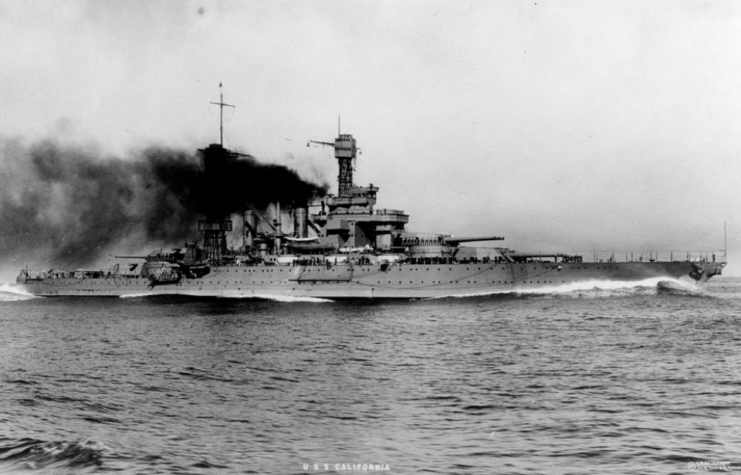
USS California (BB-44), 1921. (Photo Credit: US Navy / Naval History and Heritage Command / Wikimedia Commons / Public Domain)
Following her commission in 1921, the USS California joined the Battle Fleet as its flagship. Her interwar service was filled with training exercises, and, in 1925, the battleship, along with the rest of her Fleet, transited to Australia and New Zealand for a visit. They also stopped at American Samoa and Pago Pago on their way back to the United States.
On March 31, 1925, the Battle Fleet began receiving Curtiss TS-1 floatplanes. The following year, California received an aircraft catapult atop one of her main turrets, which allowed her to begin carrying three Vought UO-1 floatplanes. In 1930, the battleship also upgraded her armament to eight five-inch guns, which replaced the original three-inch ones.
In 1940, after a decade of exercises, training, cruises and fleet reviews, California was stationed along with the rest of the Battle Fleet in Hawaii as a deterrent to Japanese aggression. In 1941, she underwent an overhaul, and, after a visit to San Francisco, returned to Pearl Harbor.
Japanese attack on Pearl Harbor
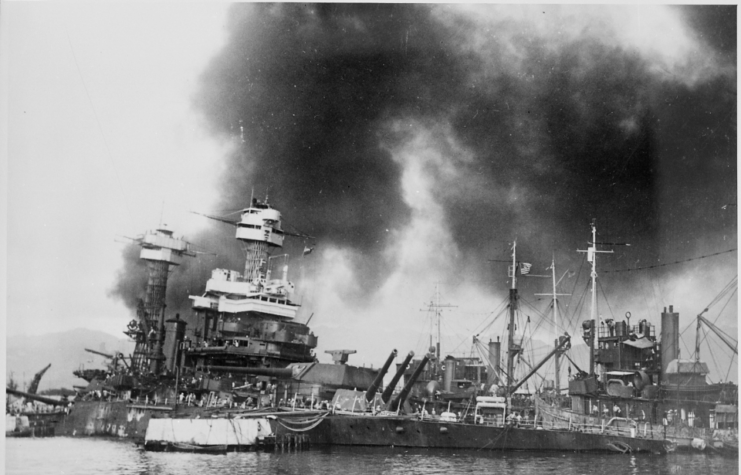
USS California (BB-44) following the Japanese attack at Pearl Harbor. (Photo Credit: US Government / National Archives and Records Administration / Wikimedia Commons / Public Domain)
On December 7, 1941, the Japanese attacked Pearl Harbor. The USS California was the southernmost ship in Battleship Row and was moored on the southeastern side of Ford Island. At the time of the attack, she had two five-inch guns and two .50-caliber machine guns standing by, in case the worst should happen.
Once the Japanese attack began, Lt. Cmdr. Marion Little ordered general quarters. At 8:03 AM, the ready guns began to fight back against the assault. California was prepared to get underway, but a Mitsubishi A6M Zero began strafing the battleship.
The ready guns ran low on ammunition and required the magazines be unlocked. While this was happening, two Nakajima B5N torpedo bombers, low on the horizon, flew toward California and dropped their torpedoes. At 8:05 AM the two torpedoes struck the battleship, one forward on the ship at frame 52 and the other further back, between frames 47 and 60.
These inflicted a great deal of damage. The forward torpedo created a 24-foot-wide hole, while the second was even worse, producing a 4o-foot-wide one. Since California was preparing for an inspection, all of the watertight doors were open, and the crew had to now contend with water rushing into the hull. The battleship slowly flooded and listed five or six degrees to port.
The Japanese continued to attack, with an Aichi D3A dive conducting bombing runs. One of these saw a bomb hit the starboard side and another almost hit the port side, causing only minor damages. Another bomb hit California at 8:45 AM, detonating within and starting a massive fire, which spread to various parts of the ship.
Despite the damage done, California‘s crew worked tirelessly to fight back and try to get her underway. Her anti-aircraft guns successfully shot down two bombers. Those working in the boiler rooms were able to restart four of the eight boilers. Despite their best efforts, the crew wasn’t able to stop the flooding. California slowly sank and settled in the mud, with water continuing to fill the ship over the following three days.
A total of 104 crew members were killed, with another 61 wounded. For their actions, four were awarded the Medal of Honor: Jackson C. Pharris, Herbert C. Jones, Thomas Reeves and Robert R. Scott.
The USS California‘s (BB-44) salvage and repair
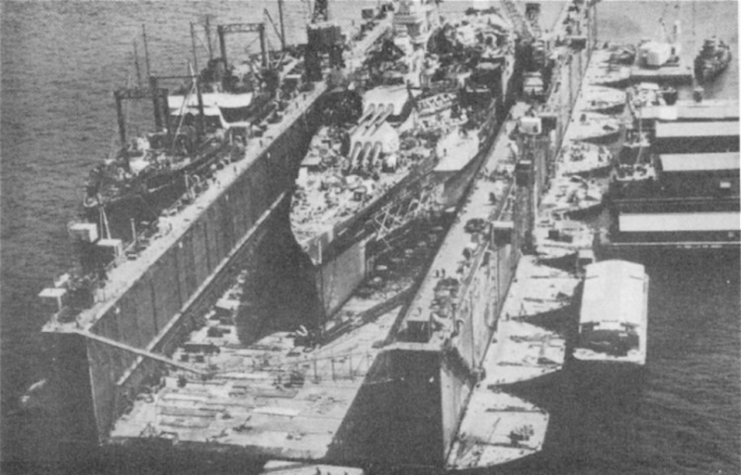
USS California (BB-44) dry docked, 1944. (Photo Credit: US Navy / Wikimedia Commons / Public Domain)
Following the attack on Pearl Harbor, the USS California was raised, which saw the ship re-floated in March 1942 and undergo extensive repairs. On April 5, an accidental explosion occurred, which took off the patch covering part of the damaged hull, and California flooded once more. Over the following days, the patch was reinstalled and, on April 9, the battleship entered dry dock. After further repairs, she was re-floated.
Numerous repairs and modernization were made to California. The secondary armament was changed to 16 five-inch guns in twin turrets. California also received forty Bofors 40 mm and forty-three 20 mm Oerlikon guns. She also had more armor added, making the ship stronger, and had her old masts exchanged with modern masts. The ship’s complement also changed.
California’s refit was completed in January 1944, and she went on to serve in the Pacific Theater for the rest of the Second World War.
Service in the Pacific Theater
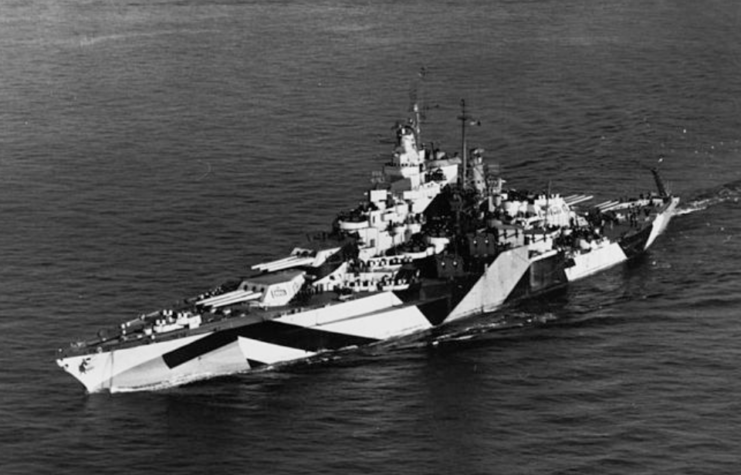
USS California (BB-44), 1944. (Photo Credit: US Navy / Naval History and Heritage Command / Wikimedia Commons / Public Domain)
Upon her return to service, the USS California joined Task Group (TG) 52.17, Fire Support Group 1, under the command of Rear Adm. Jesse B. Oldendorf. She went on to provide fire support during the invasions of Saipan, Guam and Tinian in June and July 1944 and the Leyte Campaign later in the year.
During the invasion of Lingayen Gulf in 1945, California was hit by a kamikaze. On January 6, a pair of A6M Zeros approached the ship, and while one aircraft was shot down, the other flew into the port side of the ship. This sparked a fire, which spread to a five-inch gun turret. The blaze was contained, and California was soon repaired. This attack saw the deaths of 44 men, while 155 were injured.
More from us: The Tragic Disappearance and Loss of the Argentine Submarine ARA San Juan (S-42)
Before the end of the war, California saw action during the Okinawa campaign and took part in occupation activities afterward. At the conclusion of her wartime service, the battleship returned to the US via the Indian and Atlantic Oceans. California was decommissioned in February 1947 and remained in the Reserve Fleet for 12 years, until she was stricken in March 1959.





